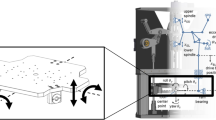Abstract
In this study, we show that stochastic analysis of metal forming process requires both a high precision and low cost numerical models in order to take into account very small perturbations on inputs (physical as well as process parameters) and to allow for numerous repeated analysis in a reasonable time. To this end, an original semi-analytical model dedicated to plain strain deep drawing based on a Bending-Under-Tension numerical model (B-U-T model) is used to accurately predict the influence of small random perturbations around a nominal solution estimated with a full scale Finite Element Model (FEM). We introduce a custom sparse variant of the Polynomial Chaos Expansion (PCE) to model the propagation of uncertainties through this model at low computational cost. Next, we apply this methodology to the deep drawing process of U-shaped metal sheet considering up to 8 random variables.












Similar content being viewed by others
References
Papeleux L, Ponthot J (2002) Finite element simulation of springback in sheet metal forming. J Mater Process Technol 125–126:785–791
Kleiber M, Rojek J, Stochi R (2002) Reliability assessment for sheet metal forming operations. Comput Methods Appl Mech Eng 191:4511–4532
de Souza T, Rolfe B (2008) Multivariate modelling of variability in sheet metal forming. J Mater Process Technol 203:1–12
Naceur H, Delaméziere A, Batoz J, Guo C, Knopf–Lenoir C (2004) Some improvement on the optimum process design in deep drawing using the inverse approach. J Mater Process Technol 146:250–262
Breitkopf P, Naceur H, Villon P (2005) Moving least squares response surface approximation: formulation and metal forming applications. Comput Struct 83:1411–1428
Kleiber M, Breitkopf P (1993) Finite elements in structural mechanics: an introduction with Pascal programs for micro-computers. Ellis Horwood
Meinders T, Burchitz I, Bonte M, Lingbeek R (2008) Numerical product design: Springback prediction, compensation and optimization. Int J Mach Tools Manuf 48(5):499–514
Radi B, El Hami A (2007) Reliability analysis of the metal forming process. Math Comput Model 45:431–439
Jansson T, Nilsson L, Moshfegh R (2008) Reliability analysis of a sheet metal forming process using monte carlo analysis and metamodels. J Mater Process Technol 202:255–268
Donglai W, Zhenshan C, Jun C (2007) Optimization and tolerance prediction of sheet metal forming process using response surface model. Comput Mater Sci 42:228–233
Blatman G, Sudret B (2011) Adaptive sparse polynomial chaso expansion based on least angle regression. J Comput Phys 230:2345–2367
Ghanem R, Spanos PD (1991) Spectral stochastic finite-element formulation for reliability analysis. J Eng Mech 117(10):2351–2372
Sudret B, Der Kiureghian A (2000) Stochastic finite elements methods and reliability- a state of the art. tech. rep. Department of civil and environmental engineering
Ghanem R, Spanos PD (1991) Stochastic finite elements: a spectral approach. Springer-Verlag, New York
Cameron R, Martin W (1944) Transformations of wiener integrals under translations. Ann Math 45(2):386–396
Xiu D (2009) Fast numerical methods for stochastic computations: a review. Commun Comput Phys 5:242–272
Berveiller M, Sudret B, Lemaire M (2006) Stochastic finite element: a non intrusive approach by regression. Rev Eur Méc Numér 15:81–92
Makinouchi A, Nakamachi E, Onate E, Wagoner R (eds) (1993) Numisheet’93 2nd international conference, numerical simulation of 3-D sheet metal forming process-verification of simulation with experiment, Riken Tokyo
Hibbit D, Karlsson B, Sorensen P. ABAQUS Example problems, vol 1, version 6.7. Dassault Système
Hill R (1948) A theory of the yielding and plastic flow of anisotropic metals. In: Proc R London, vol 193, pp 281–297
Le Quilliec G, Breitkopf P, Roelandt J, Juillard P (2013) Semi-analytical approach for plane strain sheet metal forming using a bending-under-tension numerical model. Int J Mater Form. doi:10.1007/s12289-012-1122-7
Hastie RT, Tibshirani J, Friedman G (2009) The elements of statistical learning, data mining, inference and prediction, Springer
Hesterberg T, Choi N, Meier L, Fraley C (2008) Least angle and l 1 penalized regression: a review. Stat Surv 2:61–93
Efron B, Hastie T, Johnstone I, Tibsirani T (2004) Least angle regression. Ann Stat 32(2):407–451
Acknowledgments
This research was conducted as part of the OASIS project, supported by OSEO within the contract FUI no. F1012003Z. The first author is grateful to Innoviris for its support to BB2B project entitled multicriteria optimization with uncertainty quantification applied to the building industry. The authors also acknowledge the support of Labex MS2T.
Author information
Authors and Affiliations
Corresponding author
Rights and permissions
About this article
Cite this article
Lebon, J., Le Quilliec, G., Breitkopf, P. et al. A two-pronged approach for springback variability assessment using sparse polynomial chaos expansion and multi-level simulations. Int J Mater Form 7, 275–287 (2014). https://doi.org/10.1007/s12289-013-1126-y
Received:
Accepted:
Published:
Issue Date:
DOI: https://doi.org/10.1007/s12289-013-1126-y




